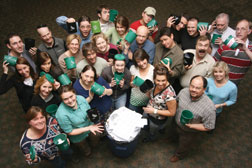 Neenan Company Recycling: Employees at Neenan display tiny trash cans. |
Construction industry companies of all sizes are turning shades of green, implementing internal sustainability practices that range from recycling paper to building LEED-platinum headquarters buildings. They are driven by an assortment of ethical, economic and marketing factors, but whatever their reasons, the shift is resulting in a change in construction's workplace environment and attitudes.
"It's the right thing to do," is the most widely heard explanation for the shift to green. Others say they are "walking the walk" or "practicing what we preach" to demonstrate their commitment to sustainability. But inevitably, they add that going green also brings significant financial benefits, including lower utility bills, improved productivity, new clients and increased competitiveness and top recruits.
Firms are turning their own office spaces into green showcases and enacting new and broader sustainability practices. Employees are petitioning executives to make the approaches corporate priorities, while employers are subsidizing public transit, expanding office recycling programs and ramping up use of other green companies in their supply chains. Pressure to employ environmentally accredited professionals is prompting organizations to subsidize continuing education in sustainability practices.
Top Down
Instituting sweeping corporate policies by board-level directives can be difficult to pull off. Many firms are doing it, but the effort it takes ranges wildly. While a 30-person consulting firm can fairly easily tally its waste, large companies, such as CH2M Hill, Denver, have to take a more complex approach just to analyze the issue of sustainability and then create a formal mechanism to manage it. CH2M Hill's approach began in 1995, when a team of 20 employees was organized and told to develop an "environmental management system" for the firm.
| + click to enlarge |
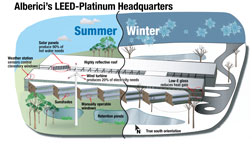 Alberici Corp LEED-platinum: Innovative features make Alberici headquarters a model for green building. |
"An EMS is a process for evaluating your environmental impact, then creating goals and processes for reducing it," says Brandy Wilson, the company's EMS manager. With 18,000 employees in 94 offices in North America using paper, water, electricity and fuel, just trying to find out about waste generation quantities "takes lots and lots of communication," Wilson says. But the company made the commitment to show "we're not just paying lip service" to the environment, she says. "Our company does a lot of environmental work, superfund sites and environmental impact statements."
The company has one employee assigned full time to its sustainability committee, while the rest come from other departments. Wilson, a technical writer, believes that's the best way to set up such a group. "If you create a separate department to do the EMS, sometimes you can get a little disconnect," she says. "By keeping everybody in those departments, we really stay close to what the needs are."
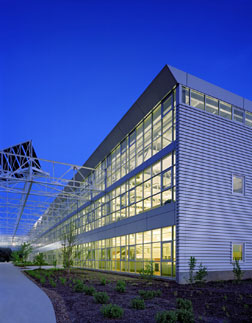 Debbie Franke Sight lines: Alberici workers all have a view. |
Internal sustainability policies also can have an external effect when big companies use such criteria when selecting subcontractors. Wilson describes how the choice of a vendor for 4-ft plotting paper was ultimately tipped by one vendor's environmental commitment. Wilson says 22% of CH2M Hill's business partners have adopted environmental policies in their internal practices. "We'd like to increase that to 30% by the end of this year," Wilson says.
Some firms are trying limit carbon emissions and are using the purchase of carbon credits to offset the remainder. "It's kind of shocking how cheap it is," says Jim Nicolow, a senior associate and the director of sustainable design at Lord, Aeck & Sargent Architecture, Atlanta. The firm is following the lead of architect Ed Mazria, who developed the "2030 Plan," an approach which can be used by any organization to reduce the carbon emitted by a building to zero by 2030.
"It's kind of obscene to hear about how we can't afford to [limit carbon emissions] because it will hurt the economy. It's such a small amount of money. It's not even going to show up on the balance sheet," says Nicolow, whose 150-person firm now spends $4,000 to $8,000 a year on carbon credits. By comparison, he says, the firm's annual air travel bill is almost $345,000.
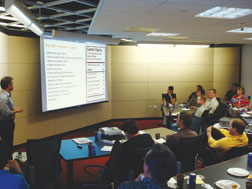 RNL Office Class: Members of RNL green team learn about LEED. |
Paul VanDuyne, president of a 400-person engineering firm, says his company wants to go paperless. By investing in large and small scanners, KJWW Inc., Rock Island, Ill., will cut down on paper use by 2009 through a corporate policy of scanning and archiving protocols. "When an RFP comes in to marketing, they usually send out bound paper copies to many different individuals. But now those will be sent out electronically," says VanDuyne, quipping that each request is "half a tree in itself."
VanDuyne says the firm, which has many LEED-certified engineers on staff, is "trying to be a good steward...but we'd like to pick up some efficiencies along the way." He says shifting from paper to electronic documents plays right into that goal by allowing him to distribute information efficiently, increase productivity and decrease response time while reducing materials use in the process.
Stantec Inc., the Edmonton, Alberta-based engineering-architecture giant, significantly ramped up its internal commitment after its acquisition of Keen Engineering, a Vancouver, British Columbia, firm with a long-standing reputation as a sustainability leader. It was one of the first to achieve LEED certification, says Laura Franceschini, appointed as Stantec's full-time sustainability coordinator in 2006. Kevin Hydes, Keen's former president and CEO and now a Stantec vice president, also is the founder of the Canadian Green Building Council and former chairman of the U.S. Green Building Council.
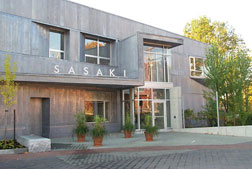 Sasaki Associates Inc. Face-lift: Sasaki hopes to spin a 150-year-old mill into LEED gold. |
Franceschini says Stantec has incorporated as many of Keen's sustainability practices as possible, although this is more difficult when scaling up to a much larger organization. Stantec's Edmonton headquarters was one of the city's first buildings to feature a green roof using native vegetation to reduce air pollution, manage stormwater runoff and offer additional cooling during hot weather. That office and the firm's Vancouver, British Columbia, office achieved LEED certification at the silver level, says Franceschini. Two others are awaiting LEED status, at the silver and gold levels.
Among other things, Stantec uses chlorine free paper and added a Mercedes-Benz "smart car" to its corporate fleet in its Victoria, British Columbia, office. The fuel-efficient, emissions-lowering vehicle was built using eco-friendly materials and manufacturing processes. "We plan to add many more such vehicles to our mix," says Franceschini. "In addition, we are working on reducing our business travel as well as reducing the impact of necessary business travel."

Post a comment to this article
Report Abusive Comment